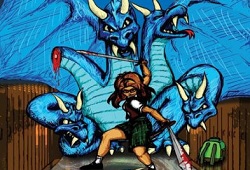
In a time before Facebook and Twitter, a time before World of Warcraft, there was Dungeons and Dragons. The forerunner of not only “massively multiplayer online role-playing games” but role-playing games of all shapes and sizes, Dungeons and Dragons was created by Gary Gygax and Dave Arneson in the early 1970s and quickly set the world of Geekdom on fire.
In 2011, Qui Nguyen debuted his new play, She Kills Monsters, a homage to geek culture in general and Dungeons and Dragons in particular. At times thrilling, often funny, and ultimately emotional and fulfilling, She Kills Monsters has seen numerous regional productions since its Off-Off-Broadway premiere. Those performances have not only been staged by local theater companies but university troupes as well, making She Kills Monsters a must-see stage experience for those just coming-of-age in addition to any-and-everyone else.
In the fall of 2018, She Kills Monsters made its Steel City debut at the University of Pittsburgh. The show’s success paved the way for a one-night repeat performance on April 18, 2019, at the August Wilson Center courtesy of the Pittsburgh Cultural Trust, where the sold-out crowd gave both She Kills Monsters and the local production an enthusiastic reception from start to finish.
Although set in 1995, She Kills Monsters still reflects contemporary times and the challenges faced by those different from so-called “accepted society.” The majority of the characters “within the game within the play” are women, for instance, while all of them (except newcomer Agnes) are non-straight in terms of sexual orientation. Seeing this ferocious group of women warriors “kill monsters” on their quest is both exhilarating and inspirational while likewise serving as an unintended metaphor for the late 2010s and beyond.
At its most basic level, She Kills Monsters is the tale of two sisters. Agnes, the eldest, has just graduated college and yearns for a life less boring. Younger sister Tilly, meanwhile, has recently died in a car accident at the age of fifteen. Agnes is more than grief stricken as she is also filled with regret – the two sisters were polar opposites and had never found the time to connect.
Agnes was strait-laced, interested in clothes and boys growing up. Tilly, on the other hand, was a “geek” in the truest sense of the word. As previously noted, the play takes place in 1995, a time when geeks were still looked down upon and ridiculed. It is later revealed that Tilly was also gay, subjecting her to even further bullying from her more “conventional” and popular fellow high school students.
In order to evade the harshness of the real world, Tilly escaped into the fantasy landscape of Dungeons and Dragons, a place where she could be the person she longed to be while likewise experiencing the life that she hoped to someday live. After Tilly’s death, Agnes stumbles upon a game scenario that her sister created, and with the assistance of a high school “expert” in Dungeons and Dragons named Chuck, enters Tilly’s world.
“This isn’t therapy,” the fictional Tilly tells Agnes. Chuck later reaffirms this observation when he is unable to reveal the inner thoughts of Tilly, explaining that although he has her notes and the ability to fill in some blanks, Agnes isn’t conversing with a true manifestation of her sister. The fictitious Tilly of the game is the best that Chuck can conjure.
Yet the game does turn out to be therapy for Agnes nonetheless as she struggles with the revelations about her sibling and attempts to understand them better. This extends into the real world outside of Dungeons and Dragons where Agnes meets the factual people that Tilly based her characters on, including the high school girl that Tilly yearned for and the forbidden nature of their relationship.
Agnes also meets the bullying cheerleaders who even frightened the fictional Tilly within the world of Dungeons and Dragons, as well as more genuine friends who enjoy the different lives they get to portray within the game.
Once the quest has ended, Tilly explains that she wanted her sister to have the “story” she wrote because, in the end, that’s all life is – a series of stories. She Kills Monsters underscores that belief by showing that loved ones can indeed live on, not only in memories but in the stories – both real and imaginary, mundane and fantastical – that they inevitably leave behind.
Agnes is ultimately given the opportunity to not only kill monsters but to slay a literal dragon as well. She succeeds and finally understands that adventure isn’t always found in the real world but in the world we create within us. That the real world isn’t always perfect, but it can be in the life we craft for ourselves. That the internal world of our imagination isn’t just a place to escape but can be used to experience the things missing from our actual lives.
These are the lessons that Tilly left behind for her sister, revealed through the story of a fifteen-year-old girl who believed in the magic of life and ultimately found fulfillment in the fictional landscape of Dungeons and Dragons, a place where she didn’t get to just kill monsters but slay the dragons of the real world as well.
Anthony Letizia

